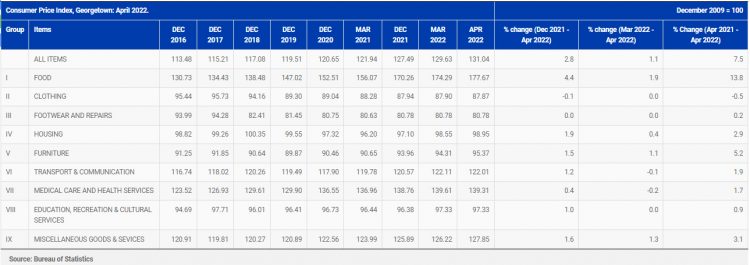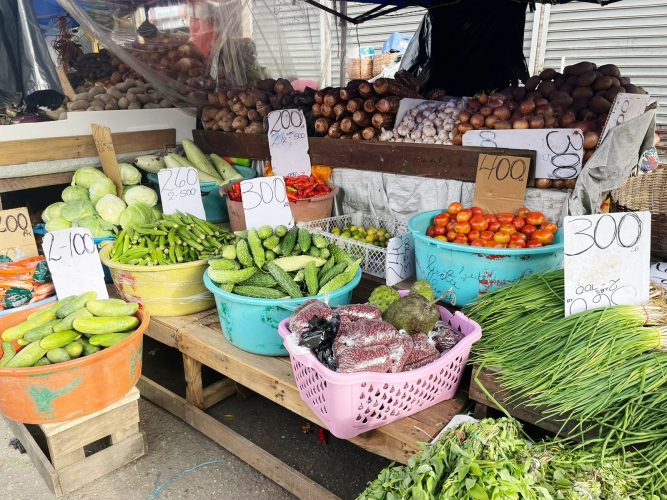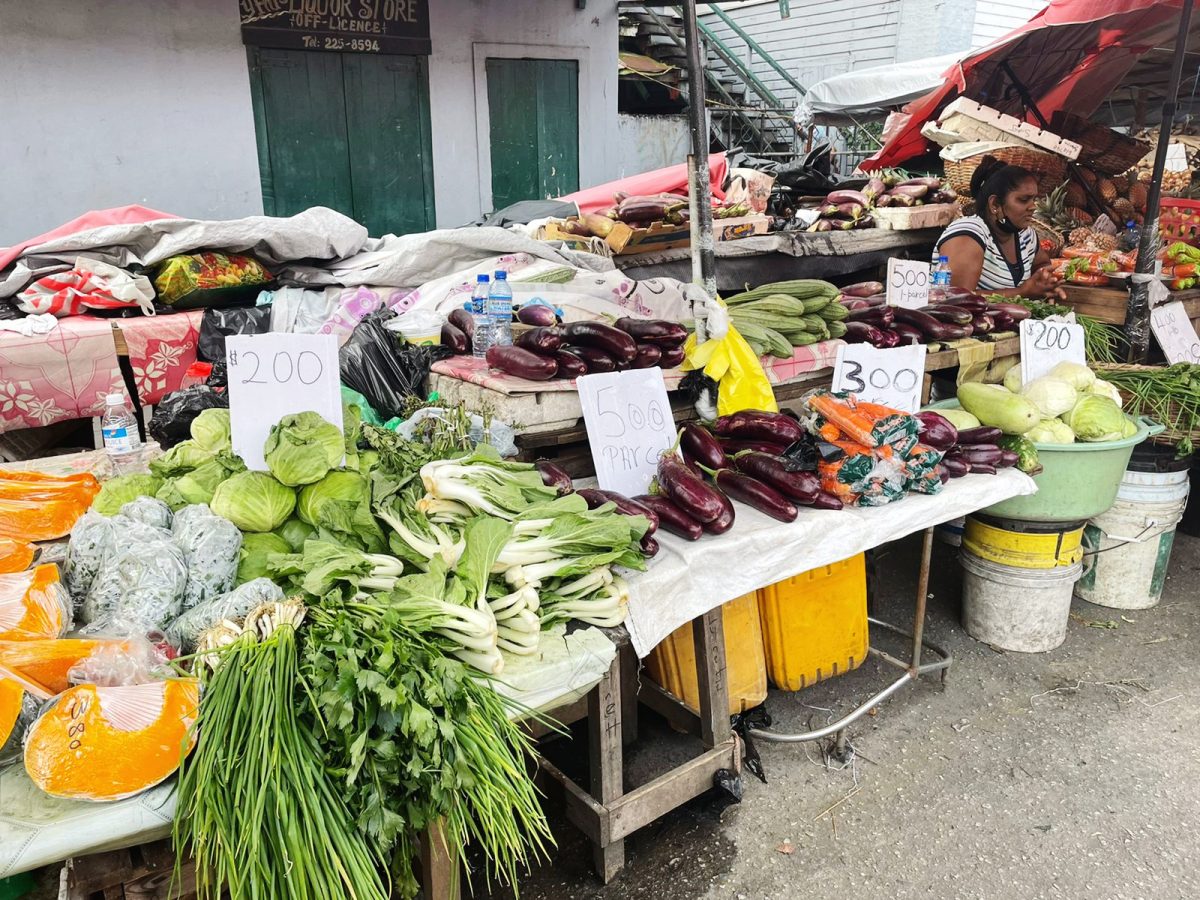The cost of living continues to rise and even though the Irfaan Ali government budgeted $5 billion to cushion the steep hikes, food and other commodity prices are continuing to climb.
The Bureau of Statistics’ Consumer Price Index (CPI) for food rose some 13.8% with an overall hike in the cost of living by 7.5% over the last year. The Bureau’s latest CPI for the month of April 2022 revealed a 1.9% hike in food prices.
The Bureau says that the Consumer Price Indices (CPI) are measured on the basis of changes in the monthly cost of a fixed basket of goods and services and prices are recorded at the retail level. This approach, it notes, is in conformity with recommended international standards used by agencies such as the United Nations Statistics Division (UNSD), International Monetary Fund (IMF), World Bank, Eurostat and International Labour Organisation (ILO).


The items which make up the baskets used by the Bureau of Statistics were selected after the completion of a Household Bud-get Survey (HBS) in 2006.
In January, Senior Minister with responsibility for Finance, Dr Ashni Singh during his 2022 budget speech had announced that Guyana saw food prices rising by some 11.6% in 2021 owing to a number of external and internal factors, including intense rainfall and the effects of the COVID-19 pandemic.
Based on accumulated numbers presented by the Bureau for the first quarter of 2022, food prices rose by 6.1%. There was a 4.4% increase reported by the Bureau for the period December 2021 to April 2022.
There was also a 2.9% increase in housing and a 1.9% increase in transportation costs for April 2022.
During his 2022 budget speech, the Finance Minister had said that the government recognizes the rise in prices but added that they have observed that it is more severe in some parts of the supply chain.
“The upward price movement at the marketplace is not reflected in similar price movement at the farm gate. Indeed, market prices have increased much more steeply than farm gate prices. This, of course, reflects a number of factors, including transportation cost and multiple layers of handling and reselling from farm to final retail.
“Given the complexity of the factors driving price increases and the limited policy instruments available to mitigate these increases, we intend to engage in further consultations with the communities most affected both on the coast and in the hinterland on possible interventions to help ease the impact on the most vulnerable in our society. To this end, we have allocated a sum of $5 billion to meet the cost of the interventions to be implemented following these consultations,” Singh had said.
Back in March, after prices continued to rise, Leader of the Opposition Aubrey Norton had called on the government to immediately implement measures to cushion the skyrocketing cost of living. He made a specific call for the government to begin tapping into the $5 billion that was set aside in the 2022 national budget to address the steep increases which were brought on by the COVID-19 pandemic and global supply chain bottlenecks.
Some of this allocation has been tapped into and the government continues to announce measures to cushion the effect of higher prices. President Ali has also been touring the country with his Cabinet and announcing one-off grants for vulnerable groups, fisher folks and others.
Markets and supermarkets
A survey of the markets and supermarkets shows that prices are continually rising without any signs of stopping. The conflict in Ukraine has also contributed to the increase of a number of items on the market.
Just last week, there was a shortage of potatoes and onions on the local market owing to supply chain issues. The situation has been temporarily rectified but on a walkthrough of Bourda Market yesterday, Stabroek News was informed that shortages are expected again shortly.
Earlier in the year, there was also a severe shortage of garlic causing the government, through the Ministry of Agriculture and the Guyana Marketing Corporation, to ration garlic and sell it in limited quantities to persons. Each person could have purchased a maximum of 10 pounds.
Yesterday, vegetable prices were relatively low compared to a week ago. However, prices for some items remain high.
On Tuesday, the Office of the Leader of the Opposition called on the government to use oil revenues to cushion the high cost of living as well as increase the national minimum wage.
“There is a real risk that oil prices will continue to rise, driving the cost of living even higher. As the country earns more revenue from these high prices; is the government going to let Guyanese suffer? Is that the plan? We are calling on the government to bring the price of gasoline down now and insulate Guyanese from any further price increases. This can be done through a continuation of the existing excise tax policy. This means implementing a negative excise tax.
“The government should ensure gas prices do not increase above a determined level by compensating suppliers for any price increases where the excise tax reductions have already been exhausted. This will help to bring prices down across a wide basket of goods, thereby easing the cost of living crisis,” the Opposition said.
In a January 2022 report, the Food and Agriculture Organisation (FAO) said that the Food Price Index reached a 10-year high in 2021, despite a small December decline. The FAO Food Price Index (FFPI) averaged 133.7 points in December 2021, down 1.2 points (0.9%) from November, but still up 25.1 points (23.1 %) from December 2020.
“Except for dairy, the values of all sub-indices encompassed by the FFPI registered monthly declines, with international prices of vegetable oils and sugar falling significantly month-on-month. For 2021 as a whole, the FFPI averaged 125.7 points, as much as 27.6 points (28.1 %) above the previous year with all sub-indices averaging sharply higher than in the previous year,” the FAO said in the report.
Earlier this month, the FAO said that the FPI averaged 157.4 points in May 2022, down 0.6% from April. The Index, which tracks monthly changes in the international prices of a basket of commonly-traded food commodities, however, remained 22.8% higher than in May 2021. It noted that World food commodity prices declined modestly in May for the second consecutive month, although wheat and poultry prices pushed higher.
Additionally, the World Bank’s report on the Global Economic Prospects said that global consumer price inflation is envisioned to peak in the first half of 2022 and then decline gradually through 2023. It noted that price pressures from shortages of key inputs and the recent run-up in commodity prices are expected to ease as global growth moderates and commodity supplies expand.
It noted that global inflation has risen at a faster pace than anticipated in recent months, resulting in steady upward revisions to consensus inflation forecasts while adding that further rises in commodity prices; continued strong demand for goods amid more persistent supply constraints; and, in some economies, sustained currency depreciation could compound inflationary pressures.





